In Windows 10, the good old Favorites folder was removed from the navigation pane in File Explorer. It was replaced by the new feature called Quick Access, which combines Favorites with Recent files and also shows frequently used folders. Here is how you can re-add Favorites to navigation pane of Windows 10 File Explorer.
Advertisеment
As of this writing, Windows 10 build 10586 retains the code to get a working Favorites folder in the Navigation pane. It works out-of-the-box and is simply not visible in the navigation pane. Using a few Registry keys taken from Windows 8.1, it is possible to restore Favorites. Here is how.
This requires Registry editing. If you prefer to avoid it, here are ready-to-use Registry files:
Download Registry Files to re-add Favorites
Unpack the ZIP archive you downloaded and double click the file named "favorites - re-add to Windows 10.reg". If you are running 64-bit Windows 10, then you must additionally merge the file named "favorites - re-add to Windows 10 - 64-bit only.reg". The changes will be applied instantly. The Favorites folder will appear in the File Explorer as shown below: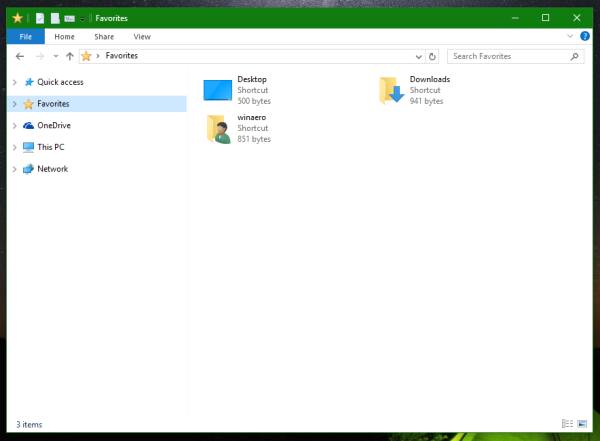
An undo file is also included, so you will be able to hide Favorites with one click.
If you are not going to use Quick Access any more, refer to this article: How to hide and remove Quick Access icon from File Explorer in Windows 10.
If you prefer to apply this tweak manually, then do the following:
- Open Registry Editor.
- Go to the following Registry path:
HKEY_CURRENT_USER\SOFTWARE\Microsoft\Windows\CurrentVersion\Explorer\Desktop\NameSpace
Tip: See how to jump to the desired Registry key with one click.
- Create here a new subkey named "{323CA680-C24D-4099-B94D-446DD2D7249E}" as shown below:
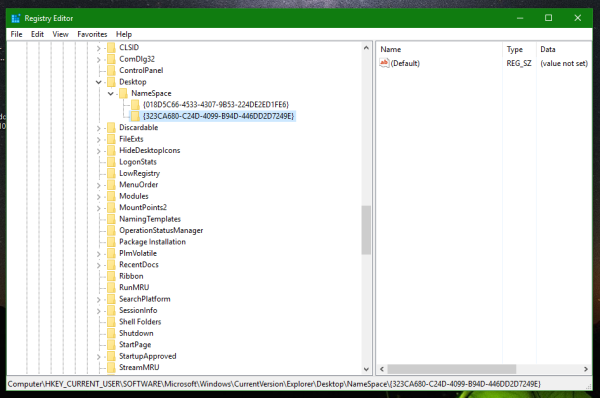
- Now, go to the following Registry key:
HKEY_CURRENT_USER\SOFTWARE\Microsoft\Windows\CurrentVersion\Explorer\HideDesktopIcons\NewStartPanel
- Create a new 32-bit DWORD value here named "{323CA680-C24D-4099-B94D-446DD2D7249E}" and set to 1. If you are running 64-bit Windows 10, you still need to create a 32-bit DWORD value. See this screenshot:
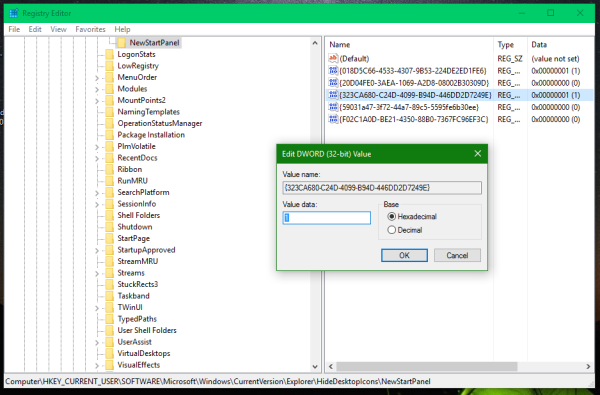
- Finally, you need to move Favorites above This PC in the navigation pane. To achieve this, go to the following Registry key:
HKEY_CURRENT_USER\SOFTWARE\Classes\CLSID
- Create a new subkey here named "{323CA680-C24D-4099-B94D-446DD2D7249E}" as you did previously.
- Under the key HKEY_CURRENT_USER\SOFTWARE\Classes\CLSID\{323CA680-C24D-4099-B94D-446DD2D7249E}, create a new 32-bit DWORD value named SortOrderIndex. Set its value data to 4 as shown below:
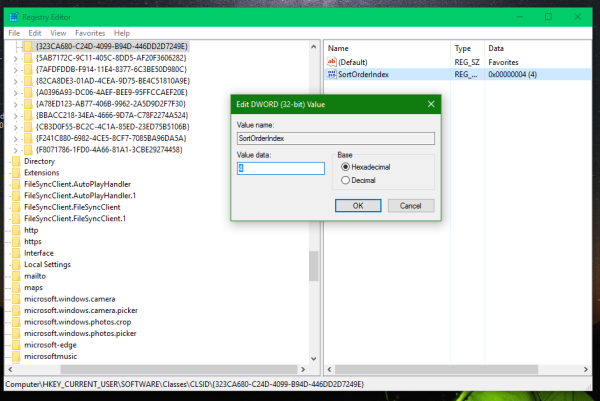
- If you are running 64-bit Windows 10, create the same subkey and the earlier mentioned value here:
HKEY_CURRENT_USER\SOFTWARE\Classes\Wow6432Node\CLSID\{323CA680-C24D-4099-B94D-446DD2D7249E}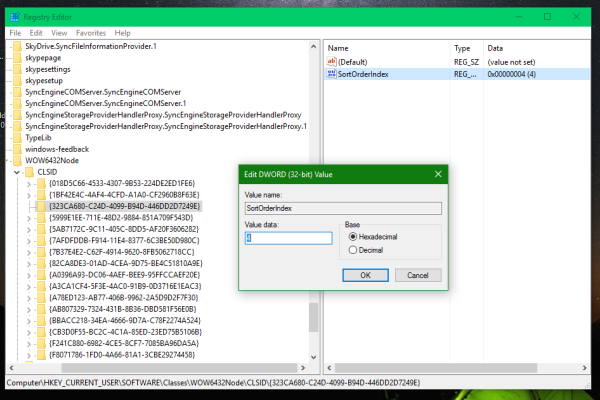
The result will be as follows:
To hide the Quick Access folder, see How to hide and remove Quick Access icon from File Explorer in Windows 10.
By default, the Favorites folder in Windows 10 contains only two links: Desktop and Downloads. You can drag and drop your own folders on the Favorites icon to add more folders.
As I mentioned at the beginning of this article, the tweak described above works perfectly in Windows 10 build 10586 and below. However, Microsoft can completely remove the Favorites functionality in the future with a new build or even with an update, so don't be surprised if some day it stops working.
That's it.
Support us
Winaero greatly relies on your support. You can help the site keep bringing you interesting and useful content and software by using these options:

Had my hopes set high for this. However It is not possible to expand Favorites. Once you click the expanding arrow (or right click-> expand) the arrow simply disappears without revealing Favorites content in left panel.
Same result here. Great to have Favorites back, but not being able to expand the folder means I have to click twice to access a Favorite. Can you fix this??
I am looking for some solution.
Did you find a result to this yet?
Unfortunately, not found yet.
Thank you for continuing to look. I hope you find something. For the moment, I am glad to at least have Favorites back.
Hi! I found a solution. You can expand folder if the folder is linked via hard link. You put the link in links folder. This is a useful tool for such linking – https://winaero.com/blog/manage-symbolic-links-hard-links-and-junctions-easily-with-link-shell-extension/
Enjoy!
For file system links, you can also use the built-in tool mklink:
Everything you need to know about symbolic links in Windows 10
Would you mind posting what the link should be?
MKLINK /D Link C:\Users\MyUsernameHere\Favorites
mklink /d “%USERPROFILE%\Favorites” “%USERPROFILE%\Links”
returned “Cannot create a file when that file already exists”
Hi John, I think the problem here is you’ve got the order backwards as well as not creating a new name to link to.
You must use the command links this:
mklink /d “%USERPROFILE%\Links\SomeName” “SourceFolder”
And replace the SomeName with whatever you want the name of the link to be, and SourceFolder with the location the link should point to.
For example to add the Desktop folder:
mklink /d “%USERPROFILE%\Links\Desktop” “%USERPROFILE%\Desktop”
Hope this helps.
Also for anyone wondering, this is working as of August 15 2018 on build# 17134.167
This does not work. There is no way to target the favorites folder with mklink because it’s not a real folder (no, it’s not %USERPROFILE%\Favorites, that seems to be a completely separate folder).
The original comment’s suggestion also does not work. When you right-click in favorites, the “Drop As” menu item does not appear.
There appears to be no way to actually make this work. Ugh.
What I can’t do like I was used to is custom sorting. Nice workaround is using zero space character, you paste it right before the name of the folder (in your favorites) and it will become the first in a row. Using multiple zero space characters you can adjust the position. Here is one for you right in the middle – “” – you can use shift and arrow keys to select it.
Thanks a lot to both the author and this helpful comment.
Short summary of steps taken:
Open CMD prompt with Admin rights.
cd %userprofile%/links
mklink /d “My Downloads” %userprofile%\Downloads
mklink /d Games d:\Games
etc..
Thanks anyway. I plan on trying to get used to the quick access. I appreciate your time!
Like everyone else, I’m looking for a way to expand the Favorites. I would probably be ok with the Quick Access folder, however the folders in it keep moving around (they are not fixed…move depending on which was opened last). Anyone have a fix for this?? thanks, Brandon.
I found no way to fix it.
You can pin Quick Access items so they don’t move (and drag and drop to sort), and also turn off recents if you want.
Thanks for these wonderful ideas with Win 10. I work at the Enterprise level with > 5000 PCs. We also have a large SharePoint installation and users find it very useful to use File Explorer (i.e. WebDAV) view of a SharePoint library. With Win 7/8 they would simply drag the address down to favorites in file explorer then rename as needed to make it meaningful.
We did your steps and it works well except if you are in any application (e.g. notepad, Word, Excel, etc) and do a “Save As” the favorites does not show in the dialog box. I have been researching and investigating registry keys but cannot find a solution.
Any ideas?
Wow this all sounds like a lot of work for a still kind of broken setup. No easy rearrangement of the order? Must set hard links…???
This is a huge factor as to why I prefer Linux. Microsoft forces “upgrades” and “improvements” while destroying old functionality. Specifically I would like to rename links and folders in my Quick access (the way favorites worked)… and this needs to work for **network drives**. Impossible with the new and improved Win10 dumpster fire
I know this is old but I’m tired of the comments all over the internet about switching to Linux. (Not trolling I promise — just griping.) It solves nothing and Linux offers much less functionality than Windows, really! Using Linux is like a deep dive into circular workarounds for weeks on end because you’re just trying to imitate the same tools offered by Windows. I did the deep dive, for months! In the end Linux was missing a couple of tools that are deal-breakers. Months wasted, but my curiosity is satisfied I guess. I suspect most will have the same result. I only gained geek-bragging-rights, and some commandline savvy. I can run Python and WLS in Windows now. Woohoo!
Oh man this sucks so hard… Why, just WHY did Microsoft had to screw this one up? Wouldn’t it have been cheaper to just leave the sodding thing alone and go make a nice latte instead? I don’t get it. The simplicity of Favorites was hard to beat. I was able to easily back up my favorites for re-deployment after re-installing the OS, furthermore, I could change the location of the Favorites folder to a non-system drive so I didn’t even need to back them up. Now, with the new Quick Access, I can’t do any of that. Not only that, Windows keeps adding recently used items to the bottom of the list, some of which are often duplicated. It’s insulting to our intelligence. Just like when they removed the Up button in Explorer, or the Start button, only to bring them back in later revisions of the OS. Microsoft should have confidence that they have got some things right and there’s no need to re-invent the wheel, making it square, oval, etc, and then realizing round was alright. If your developers have nothing to do, then maybe they could implement scroll wheel acceleration, or better windows management (snapping) features. Or a start menu that doesn’t suck balls. All you have to do is look at all the cool third-party utilities like WinAero Tweaker, Classic Shell, etc, to see what you are not doing. Classic Shell is out there because you can’t do your job, and yet you have time to go screwing things up, and waste thousands upon thousands of users’ time trying to tweak the OS back to working like it used to in earlier versions (namely Windows 7, for the most part). This is extremely infuriating…
They ARE listening. That’s what Windows Error Reporting, Windows Feedback, and the telemetry data are about, and people hate it. Just sayin’!
Looks like this created a “library” folder for me….anybody have a way to turn this into the “Favorites” folder??
Was really hoping this would work so I could finally be rid of Quick Access. However, when I the files on my Enterprise LTSB 2016 x64 VM they did nothing.
Man, I thought I finally found a solution. But when I add the regedits the Favorites shows up, but it won’t list the contents.
Good morning everybody,
In my case, I cannot even find the path. I mean, I found similar folders, but not in the indicated paths
Regards
@Dean Wood – and anybody else missing this favorites in a “Save File” dialog window:
I’ve found no way to make this favorites visible in the navigation panel (left sidebar) of a “Save file…” dialog window.
However, you can still access this favorites, by using the windows breadcrumb navigation in the address bar. Windows 10 shows not a real path in this bar, instead the path-parts are listet, with little arrows in between them. Click on the most left arrow there and a drop-down menu will appear, the favorites can be accessed there.
At least that’s the case right now, 19. November 2018.
Btw, thank you, winaero, for this explorer-fix! Just great!
And while i’m on it, dear Microsoft: fck u. Seriously, just fck u. So much power to make the IT-world a better place, still making one mistake after another…
I just upgraded to Windows 10 and this drove me nuts. For those of you trying to add favorites to network paths, you’ll need to do an extra MKLINK layer. What I did was create a symlink to the network location (using MKLINK /D) with the name “symlink” appended to the end. I then created a junction to the symlink (MKLINK /J) and named it what I actually wanted to show up in Quick Access. I added this final result to quick access and got what I needed in a way more complicated way then used to be possible.
@Unnecessarily jumping through hoops:
Adding networked shortcuts to Quick Access is not what this article is about. In addition it is a really bad idea. When I added some networked locations, by right-clicking Quick Access while in their folder, Explorer slowed to a crawl when the said locations were unavailable — all Explorer windows in the entire computer! Disabling Quick Access through Winaero Tweaker fixed it, but I cannot remove the shortcuts from Quick Access now, as long as the locations are unavailable (that computer no longer exists.) Still trying to figure that out. Meanwhile, I’m using Favorites, and NOT placing networked shortcuts there, JIK. I’ve placed network shortcuts in a rarely used partition for now. I expand that to open my shortcuts. It is not in Favorites or Quick Access. *Sigh!*
So what I need is a way to shortcut networked locations, without slowing down Explorer, whether the locations are available or not. I use one computer in the house as network storage for all the other computers. It is just a Windows 10 computer, not NAS or anything special. We access it a lot because our video and Plex server are there. Shortcuts, when available, open much faster than surfing through the traditional Network dropdown because they don’t search the entire network every time you open them. I need Windows to leave my shortcuts alone until I specifically access them (and then let me delete them when they’re offline if needed.)
I believe Favorites used to let me do this with network shortcuts in Windows 7. That’s why I tried it with Quick Access. Not sure if Favorites still works this way. I’ll experiment and let y’all know.